Auto start/stop systems are becoming increasingly common in modern vehicles as automakers incorporate the feature to improve fuel efficiency and reduce emissions. The concept is straightforward—the system shuts off the engine when the car comes to a complete stop, restarting it when you release the brake or press the accelerator. Now, imagine this scenario occurring every time you stop at a red light, stop sign, or in traffic. Isn’t this hard on the engine and parts like the starter and alternator?
The Basics: Understanding Auto Start/Stop
How much time do you spend in the driver’s seat? More importantly, how much time do you spend in the driver’s seat going nowhere? The Texas A&M Transportation Institute released a study in 2024 that found Americans spend an average of 54 hours a year stuck in traffic. Your commute not only costs you valuable time, but also money as your vehicle burns fuel every minute the engine is running. Auto start/stop systems are designed to mitigate this consumption, improving efficiency and reducing emissions by turning off the engine when it’s not needed.
How It Works: A Collaborative Effort
Experiencing this feature for the first time can be alarming because the engine shuts off, sometimes reducing the performance of other features, like the air conditioner, heater, infotainment system, and lights. Depending on the system, you can be stopped in traffic for a few minutes and notice the air conditioner isn’t running full blast. Why does this happen?
Auto start/stop systems are collaborative, meaning they rely on components such as the battery, starter, engine control unit, and alternator to function seamlessly. When the auto start/stop system shuts the engine off, it’s up to the battery to power the electrical components. Once you release the brake, the starter cranks the engine, and the alternator resumes its job of charging the battery and handling the demands of your car’s electrical components.

The Potential Impact
Repeatedly cold-starting an engine isn’t ideal and can lead to premature wear. But what does this have to do with auto start/stop? Most auto start/stop systems will not force the engine to cold start. Instead, auto start/stop systems engage when the engine is warm or in a normal operating state. It’s not a cycle of cold-starting the engine as you navigate your commute or run errands in town. Yet, wear and tear on your vehicle is still something to consider.
The Starter: Getting Your Engine Going
Wear and tear on the starter motor is a common cause for concern with auto start/stop systems. This is a small electric motor used to turn over the engine and get it running after it has been turned off. The clicking you hear when you try to start your car with a dead battery is the starter motor. Traditionally, it sees very little use, as you only need it to get the car started at the beginning of your journey.
The Alternator: Your Vehicle’s Power Bank
The alternator is another critical component of your vehicle’s electrical system because it converts mechanical energy from the engine into electrical energy that charges the battery and powers your car’s various electrical components, from the infotainment system and lights to the air conditioner and heater. Vehicles without an auto start/stop system rely on the alternator to work behind the scenes as the engine runs, actively managing your car’s electrical demands and supplying energy to the battery.
Built to Handle the Demands
With an auto start/stop system, the starter and alternator’s jobs don’t change, but the frequency does. The system uses the starter every time you come to a stop and forces the alternator to engage on demand rather than maintain a constant operating environment. The situation requires a few heavy-duty upgrades to ensure the components can withstand the conditions and deliver the same level of performance every time the engine restarts.
Heavy-Duty Alternators and Starters
Vehicles with auto start/stop have a more durable alternator and starter, as well as better charging systems and advanced battery technologies. The alternator usually features more robust components, such as reinforced bearings and an improved cooling system. Typically, auto start/stop systems rely on a reinforced starter that can withstand thousands of start cycles, ensuring it can last longer and reduce the overall strain on the alternator and other components in the electrical system.
Advanced Batteries and Charging Systems
Beyond a heavy-duty alternator and starter, auto start/stop cars, trucks, and SUVs typically feature improved charging systems and batteries. Intelligent charging systems can optimize the alternator’s operation by monitoring the battery’s state of charge. When the state of charge reaches a certain threshold, it activates the alternator, engaging the system as needed and thereby reducing the demands.
Another crucial upgrade is the battery. A conventional car battery isn’t designed for continuous charging and discharging. They can’t withstand those demands, which is why most auto start/stop vehicles have AGM or EFB batteries. AGM, which stands for Absorbed Glass Mat, batteries are renowned for their cold-start capabilities and offer a balanced state of charge that can dramatically reduce the demands on the alternator and minimize the energy required during restarts.

Navigating Life and the Road With Auto Start/Stop
Your vehicle’s auto start/stop system works behind the scenes, but that doesn’t mean it’s entirely forgettable or easy to ignore. The system has a widespread impact, affecting everything from your experience behind the wheel to the wear and tear on the engine.
Your Driving Experience
Auto start/stop technology has created a heated debate between those who love it and many others who hate it. For some, the engine stopping every time they engage the brake for a complete stop is frustrating because it hinders other features and doesn’t feel natural. This dissatisfaction has led to an expansive catalog of aftermarket components that disable the feature.
For other drivers, auto start/stop might be standard on their vehicle, but its impact is minimal. Auto start/stop systems are most felt when navigating urban landscapes where stops are frequent. If you spend most of your time on the highway or in rural areas with little traffic and even fewer stop lights, the system doesn’t engage as often and has less of an impact on your car’s fuel economy and emissions.
Maintenance Needs
Auto start/stop systems can effectively improve your car’s fuel economy, but how do those savings at the pump compare to maintenance needs and long-term wear and tear? For starters, AGM and EFB batteries are significantly more expensive than conventional batteries, and due to higher and more frequent demands, they may need to be replaced more often. Likewise, ongoing wear and tear on the starter and alternator may lead to more frequent replacements, which can be costly, as these parts are of higher quality.
The Big Picture
Will auto start/stop put additional wear and tear on your vehicle? The short answer is a resounding, “Yes.” Any feature that impacts your engine’s performance, forcing it to start and restart, causes wear and tear. However, automakers attempt to mitigate that wear by equipping their models with heavy-duty starters and alternators, advanced batteries, and intelligent charging systems. While the components are built to withstand the extreme conditions, there’s no way to ignore or avoid the increased workload.
Does this mean auto start/stop is inherently bad for cars, trucks, and SUVs? Wear and tear on your vehicle occurs with every mile logged on your odometer. Auto start/stop systems aren’t designed to eliminate the wear and tear on your engine, but to mitigate fuel consumption and reduce emissions. With Americans spending over 50 hours stuck in traffic each year, the technology can result in noticeable fuel savings. In that regard, auto start/stop does its job effectively.
So, what side do you fall on in the debate? Are you among the many drivers who benefit from auto start/stop? Or have you already invested in an aftermarket component to turn the feature off, allowing the engine to rumble as time and experience have taught us it should?

